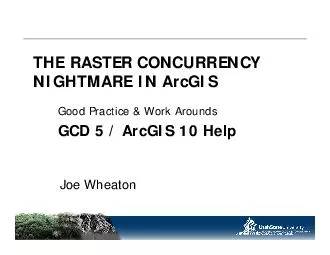/


Good Practice Work AroundsGCD 5 ArcGIS 10 HelpJoe Wheaton IDefinitionsIIProblem with IgnoringIIIWhat ArcGIS doesIVWhy is it so hard to fix The crux of the VWhat GCD requires and whyVIGood ID: 148782
Download Pdf The PPT/PDF document "THE RASTER CONCURRENCY NIGHTMARE IN ArcG..." is the property of its rightful owner. Permission is granted to download and print the materials on this web site for personal, non-commercial use only, and to display it on your personal computer provided you do not modify the materials and that you retain all copyright notices contained in the materials. By downloading content from our website, you accept the terms of this agreement.
THE RASTER CONCURRENCY NIGHTMARE IN ArcGIS Good Practice & Work AroundsGCD 5 / ArcGIS 10 HelpJoe Wheaton I.DefinitionsII.Problem with IgnoringIII.What ArcGIS doesIV.Why is it so hard to fix? The crux of the V.What GCD requires and why?VI.Good practice & Workarounds RASTER TERMINOLOGYAll rasters have the following Number of columns & rows (must Cell resolution (grid size)Type (integer, floating point Lower left coordinates (x,y) or Top, Bottom, Right & Left coordinates From which the following secondary properties can be Width & Height Orthogonal rasters Share exact same grid Share the exact same in both easting and Grids are orthogonal Share TopBottom Rasters that have the simply have the same nodatacellsThe mask can be A concurrent raster I.DefinitionsII.Problem with IgnoringIII.What ArcGIS doesIV.Why is it so hard to fix? The crux of the V.What GCD requires and why?VI.Good practice & Workarounds TO DO MAP ALGEBRA, RASTERS NEED TO Compatibility defined CHANGE DETECTION WITH DEM DIFFERENCING A cell-by-cell analysis, which requires concurrent grids© Wheaton (2008) Erosion Erosion Deposition Deposition WHAT DO I REALLY NEED?Orthogonality?Yes, because if not what cell values Concurrency?Helps, but if some cells only exist within extents of one raster, then no calculation is possibleAll cells have a value (i.e. same Sort of can only do MOST calculations (e.g. subtraction) when all Some operations (e.g. max) may still Raster 1Raster 2Raster CalculatedFrom Raster 1 & 2 SAME NUMBERS & ROWS, BUT Same resolution, same Same resolution, (but same width & orientation, same origin EVER SEEN SOMETHING LIKE THIS?The consistent They are minor They are artifacts of original raster I.DefinitionsII.Problem with IgnoringIII.What ArcGIS doesIV.Why is it so hard to fix? The crux of the V.What GCD requires and why?VI.Good practice & Workarounds If you give ArcGIS two overlapping but non-orthogonal rasters, it just lets you It does this by a combination of using The result is the geoprocessingtool For extents, it tends to take the intersection as For cell size, it tends to take Maximum of inputs: EVERY TOOL HAS ENVIRONMENT SETTINGSTools validate parameter values as you enter them They also can override ENVIRONMENT SETTINGS PRIORITY? How? Nearest NeighborBilinear InterpolationDistance weighted average of four nearest cell centersCubic Convolution I.DefinitionsII.Problem with IgnoringIII.What ArcGIS doesIV.Why is it so hard to fix? The crux of the V.What GCD requires and why?VI.Good practice & Workarounds WHERE PROBLEMS COMES FROMMost people derive rasters from precise vector data, which introduces unnecessarily specific ArcGIS is inconsistent in raster geoprocessingIf priority is given to grid resolution youll often get If priority is given to rows and columns, you will get RASTER CREATIONLets look at an example I.DefinitionsII.Problem with IgnoringIII.What ArcGIS doesIV.Why is it so hard to fix? The crux of the V.What GCD requires and why?VI.Good practice & Workarounds Concurrent grids to do change detection In GCD 5.0.1 5.0.4 BETA, its not enforced at Survey Library, its enforced at concurrent, you get an error message) No need to introduce further interpolation errors from resampling that the user is unaware ofOur underlying code (C++ library) is set up to require this as an input (we dont use Arcs geoprocessingfor most of the change detection)In future (shield user from some of this):We are going to enforce orthognoalityupon upload to We are only going to enforce concurrency at time of change detection, based on interesectionof two I.DefinitionsII.Problem with IgnoringIII.What ArcGIS doesIV.Why is it so hard to fix? The crux of the V.What GCD requires and why?VI.Good practice & Workarounds SOME GOOD PRACTICEUse even integers wherever possible for extents to simplify orthogonalityproblemsNEVER use cell resolutions that are not evenly divisible ALWAYS, exert explicit control over extents and grid Once you get one raster defined, match its extents & cell Avoid resampling if at all possibleIf you must resample, be careful not to introduce Best thing to do is exert explicit control over cell size selection and raster extents at stage of that raster width and height are evenly divisible by cell sizeThats not always possibleHeres two common problems:1.Two non-concurrent DEMs2.Two apparently concurrent DEMs, but .